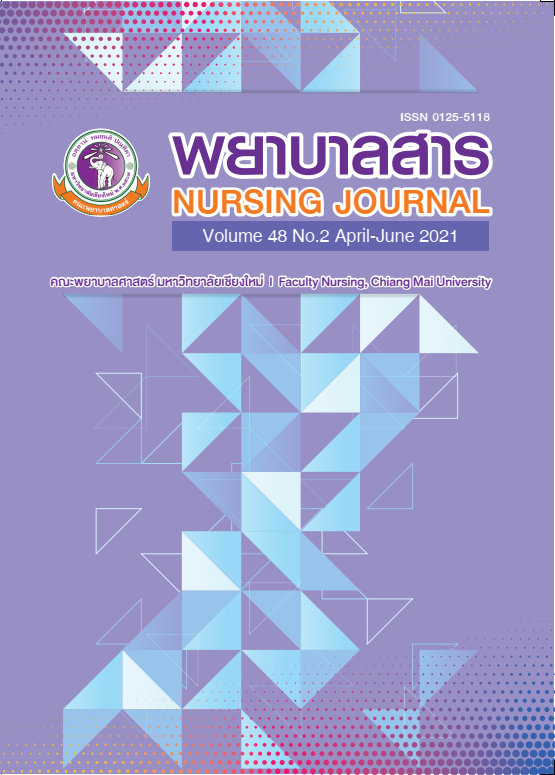Development of Smartphone Application in Preventing Infection for School-age Children
Keywords:
Application, infection control, School-age Children, smartphoneAbstract
Infection in school-age children is a serious problem. If undetected it can affect growth and development. It is important to learn about infection prevention and control. This developmental research study aimed to develop, test the efficiency, and examine satisfaction of a Smartphone application in preventing infection for school-age children. This study was conducted between June 2016 – September 2018 and used random sampling to select 42 students who were studying at a demonstration primary school. The research instruments used for the intervention included the Smartphone application that was developed by the researcher; and instruments for data collection were the infection prevention knowledge tests and satisfaction questionnaire. The instruments were validated by an expert panel and the content validity index for the different sections were .89, .80 and .97. The reliability value of the knowledge tests was .71 and .72. The application development process was based on 7 steps of the System Development Life Cycle and included: 1) problem definition, 2) analysis, 3) design, 4) development, 5) testing, 6) implementation phase, and 7) maintenance. The application was tested on individuals, small groups and by field test. Data were analyzed using descriptive statistics.
The results of the study showed that the efficiency of the smartphone application was 80.03/82.29 which was considered an efficient level. User satisfaction of the application with regards to design, content, media instruction and use were at 100% satisfaction.
This smartphone application in preventing infection for school-age children is recommended for use in school-age children to increase their knowledge on preventing infection. For further study, it is suggested to compare the effect of the smartphone application in preventing infection behavior for school-age children.
References
Chanthip, P. (2011). Construction of electronic book on web on diabetes for nursing students (Master of Education Program in Educational Communications and Technology). Graduate School, Kasetsart University. (In Thai)
Günizi, H. (2014). The prevalence and risk factors of secretory otitis media in elementary school students in Hakkari city center. European Journal of Medical Sciences, 1(3), 97-101.
Kananit, S. (2015). Development of application for learning on the operating system Android.
health education at Mathayom 1. Retrieved from https:// summon kananit.wikispaces.com /file/view/ application research.pdf (In Thai)
Knowles M., et al. (2005). The adult learner: The definitive classic in adult education and human resource development (6th ed.). Amsterdam: Elsevier.
Nabundit, R., & Tangvoraphonkchai, J. (2012). The effects of innovation in providing health information and health game on self-care behaviors for adolescent admitted SLE patients. Journal of Nursing Science and Health, 35(1), 10-17. (In Thai)
Pasavano, T. (2013). Edutainment: New trend in education with focus on entertainment. Valaya Alongkorn Review, 3(2),159-167. (In Thai)
Phetin, M. (2003). Cartoons in class. Journal of Science and Mathematics Education and Technology, 31(122), 47-50. (In Thai)
Plachaipiromsil, S. (2011). Usages trend of mobile application. Executive Journal, 31(4),110-115. (In Thai)
Posfay-Barbe, K. M., Zerr, D. M., & Pittet, D. (2008). Infection control in pediatrics. The Lancet infectious diseases, 8(1), 19-31.
Radack, G. (2002). WG3 Presentation to SC4 Opening Plenary-TC4-STEP-Manufacturing, 10, 1-4.
Singdee, B. & Satpretpry, S. (2014). Research and development of application instruction media on tablet android operation system in career and technology subject for Mattayomsuksa 1. National and International Conference Interdisciplinary Research for Local Development Sustainability.15, 623-634. (In Thai)
Siripanichakorn, K. (1998). Infectious disease (2nd ed.). Bangkok: Holistic publishing. (In Thai)
Songkarm, N. (2010). Design and development of multimedia for learning. Bangkok: Chulalongkorn University. (In Thai)
Tachawong, K, Picheamsathain, W, & Chintanawat,R. (2011). Effects of information provision using a comic book on school-aged patients’ knowledge’s and practices in prevention of nosocomial infection. Nursing Journal, 38(1), 62-73 (In Thai)
Thaiyapirom, N. & Klunklin, P. (2011). Child Health Promotion I. Chiangmai: Kongchang printing. (In Thai)
Downloads
Published
How to Cite
Issue
Section
License
บทความที่ได้รับการตีพิมพ์เป็นลิขสิทธิ์ของวารสารพยาบาลสาร
ข้อความที่ปรากฏในบทความแต่ละเรื่องในวารสารวิชาการเล่มนี้เป็นความคิดเห็นส่วนตัวของผู้เขียนแต่ละท่านไม่เกี่ยวข้องกับมหาวิทยาลัยเชียงใหม่ และคณาจารย์ท่านอื่นๆในมหาวิทยาลัยฯ แต่อย่างใด ความรับผิดชอบองค์ประกอบทั้งหมดของบทความแต่ละเรื่องเป็นของผู้เขียนแต่ละท่าน หากมีความผิดพลาดใด ๆ ผู้เขียนแต่ละท่านจะรับผิดชอบบทความของตนเองแต่ผู้เดียว






